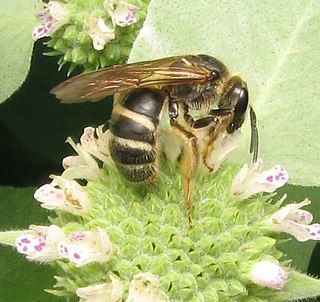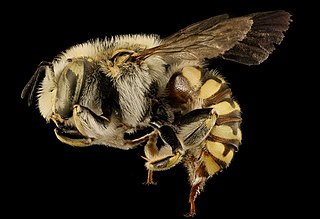
Ophrys apifera, known in Europe as the bee orchid, is a perennial herbaceous plant of the family Orchidaceae. It is remarkable as an example of sexually-deceptive pollination and floral mimicry as well as of a highly-selective and highly evolved plant–pollinator relationship.

The Bee Gees were a music group formed in 1958. Their lineup consisted of brothers Barry, Robin, and Maurice Gibb. The trio were especially successful as a popular music act in the late 1960s and early 1970s, and later as prominent performers of the disco music era in the mid-to-late 1970s. The group sang recognisable three-part tight harmonies; Robin's clear vibrato lead vocals were a hallmark of their earlier hits, while Barry's R&B falsetto became their signature sound during the mid-to-late 1970s and 1980s. The Bee Gees wrote all of their own hits, as well as writing and producing several major hits for other artists. The Bee Gees are widely referred to by many critics, media outlets and fellow artists as the "Kings of Disco".

Ophrys lutea, the yellow bee-orchid, is a species of orchid native to southern Europe, North Africa, and the Middle East, the range extending from Portugal and Morocco to Syria.

Phragmites is a genus of four species of large perennial reed grasses found in wetlands throughout temperate and tropical regions of the world.

Scarabaeoidea is a superfamily of beetles, the only subgroup of the infraorder Scarabaeiformia. Around 35,000 species are placed in this superfamily and some 200 new species are described each year. Its constituent families are also undergoing revision presently, and the family list below is only preliminary.

The sweat bee genus Lasioglossum is the largest of all bee genera, containing over 1700 species in numerous subgenera worldwide. They are highly variable in size, coloration, and sculpture; among the more unusual variants, some are cleptoparasites, some are nocturnal, and some are oligolectic. Most Lasioglossum species nest in the ground, but some nest in rotten logs.
Anthidium vigintiduopunctatum is a species of bee in the family Megachilidae, the leaf-cutter, carder, or mason bees.
Anthidium utahense is a species of bee in the family Megachilidae, the leaf-cutter, carder, or mason bees.
Anthidium syriacum is a species of bee in the family Megachilidae, the leaf-cutter, carder, or mason bees.
Anthidium rubripes is a species of bee in the family Megachilidae, the leaf-cutter, carder, or mason bees.

Anthidium porterae is a species of bee in the family Megachilidae, the leaf-cutter, carder, or mason bees. This bee was named in honour of Wilmatte Porter Cockerell.

Anthidium palliventre is a species of bee in the family Megachilidae, the leaf-cutter, carder, or mason bees.
Anthidium mormonum is a species of bee in the family Megachilidae, the leaf-cutter, carder, or mason bees.

Anthidium maculifrons is a species of bee in the family Megachilidae, the leaf-cutter, carder, or mason bees.
Anthidium latum is a species of bee in the family Megachilidae, the leaf-cutter, carder, or mason bees.
Anthidium funereum is a species of bee in the family Megachilidae, the leaf-cutter, carder, or mason bees.
Anthidium emarginatum is a species of bee in the family Megachilidae, the leaf-cutter, carder, or mason bees.
Anthidium danieli is a species of bee in the family Megachilidae, the leaf-cutter, carder bee, or mason bees.
Anthidium aymara is a species of bee in the family Megachilidae, the leaf-cutter, carder, or mason bees.








